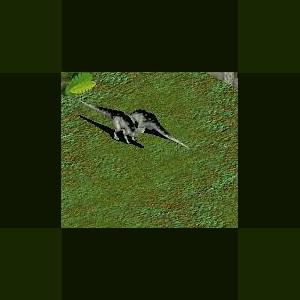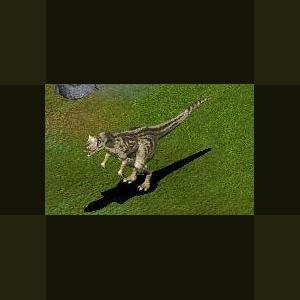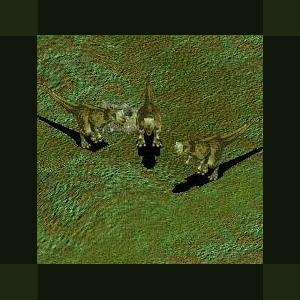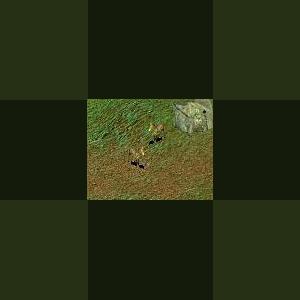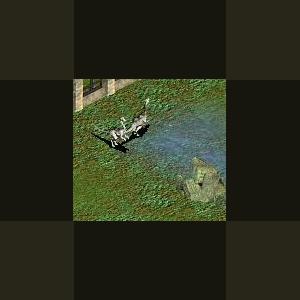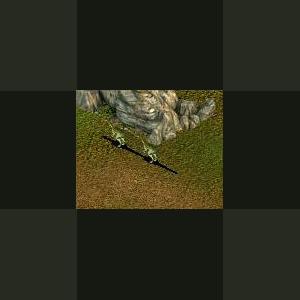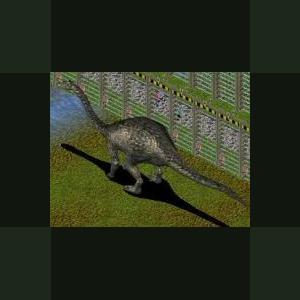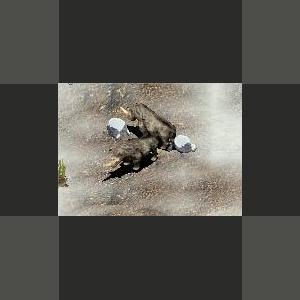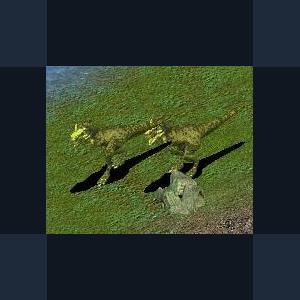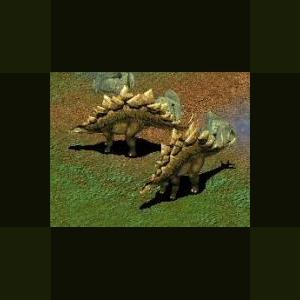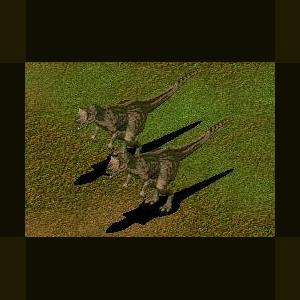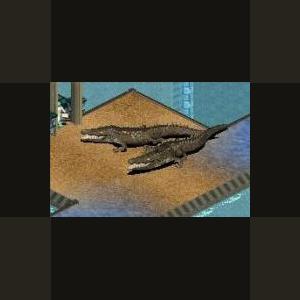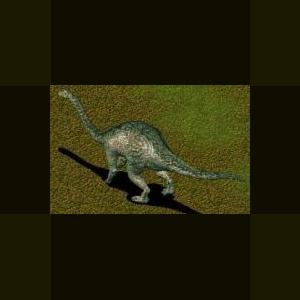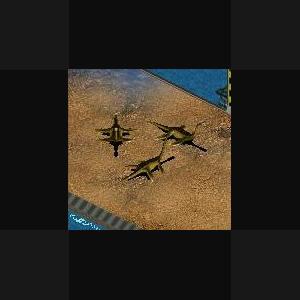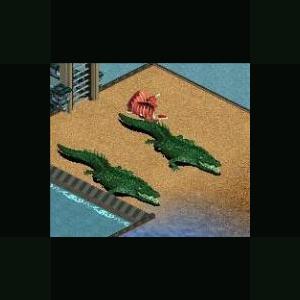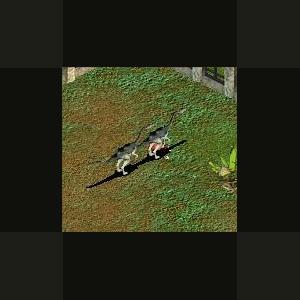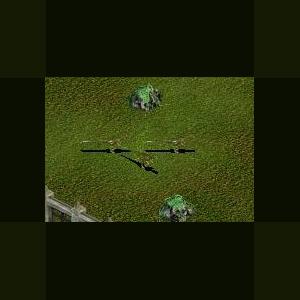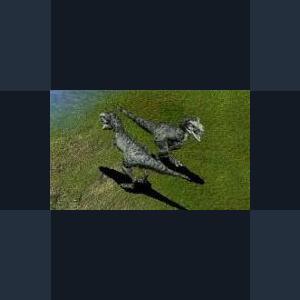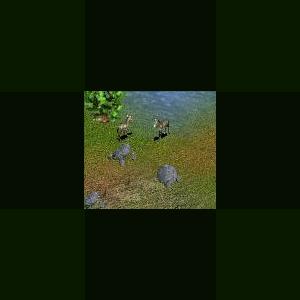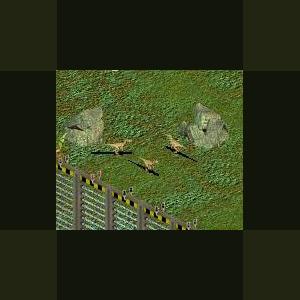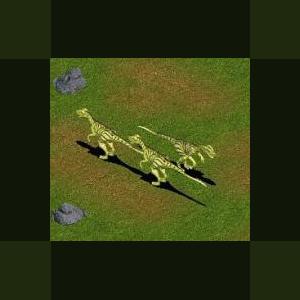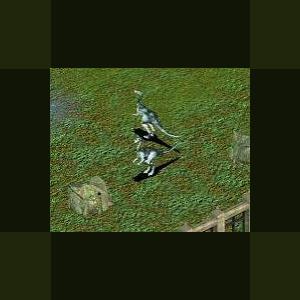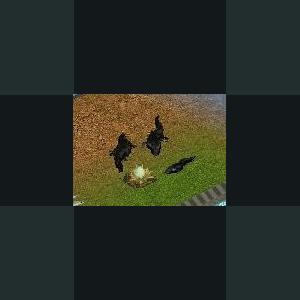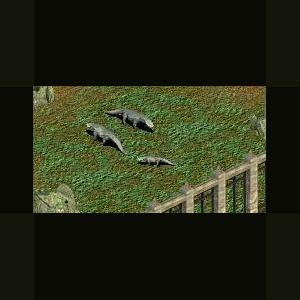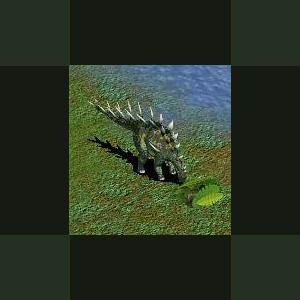Dinosaurs
Creatures from another age
241 files
-
Aralosaurus by Moondawg
By Guest
Aralosaurus (ar-ahl-o-SORE-us) meaning "Aral Sea lizard", because it was found in the Aral Sea when it began to shrink noticeably.Aralosaurus was a genus of hadrosaurid dinosaur which lived during the Late Cretaceous of what is now Kazakhstan.
Aralosaurus was characterized by a small, bony peak on its nose, much like its relatives Maiasaura and Gryposaurus. Some paleontologists have posited that Aralosaurus was actually a lambeosaurine.
Aralosaurus was a herbivore that lived in the late Cretaceous period, around 95 to 80 million years ago, and was capable of both bipedal and quadrupedal movement. Egg clusters show that Aralosaurus lived in herds and had locations for laying eggs where they would be safe.Several relatives, such as Jaxartosaurus have also been found in the surrounding area where Aralosaurus was found.
Aralosaurus was about the size of an elephant, being up to 9 m long, but was over 5,000 kilograms in weight. Although very little is known about Aralosaurus (only one near complete skull has been found); it was identified by a beak with nearly 1,000 small teeth in 30 rows. These teeth were used for breaking up plant matter by chewing, a feature common in herbivorous dinosaurs, but unusual for reptiles.The back of an Aralosaurus skull was wide, a feature suggestive of large jaw muscles used to power its chewing apparatus
335 downloads
0 comments
Updated
-
Acrocanthosaurus by Moondawg
By Guest
Acrocanthosaurus (pronounced ak-ro-KAN-tho-SAWR-us; meaning 'high-spined lizard') is a genus of allosauroid theropod dinosaur that existed in what is now North America during the mid-Cretaceous Period
The skull of Acrocanthosaurus, like most other allosauroids, was long, low and narrow. The weight-reducing opening in front of the eye socket (antorbital fenestra) was quite large, more than a quarter of the length of the skull and two-thirds of its height. The outside surface of the maxilla (upper jaw bone) and the upper surface of the nasal bone on the roof of the snout were not nearly as rough-textured as those of Giganotosaurus or Carcharodontosaurus. Long, low ridges arose from the nasal bones, running along each side of the snout from the nostril back to the eye, where they continued onto the lacrimal bones. This is a characteristic feature of all allosauroids. Unlike Allosaurus, there was no prominent crest on the lacrimal bone in front of the eye. The lacrimal and postorbital bones met to form a thick brow over the eye, as seen in carcharodontosaurids and the unrelated abelisaurids. Nineteen curved, serrated teeth lined each side of the upper jaw, but a tooth count for the lower jaw has not been published. Acrocanthosaurus teeth were wider than those of Carcharodontosaurus and did not have the wrinkled texture that characterized the carcharodontosaurids. The dentary (tooth-bearing lower jaw bone) was squared off at the front edge, as in Giganotosaurus, and shallow, while the rest of the jaw behind it became very deep. Acrocanthosaurus and Giganotosaurus shared a thick horizontal ridge on the outside surface of the surangular bone of the lower jaw, underneath the articulation with the skull.
484 downloads
Updated
-
Fukuiraptor by Moondawg
By Guest
now Japan.
Scientists first thought it was a member of the Dromaeosauridae, but after studying the fossils they now believe it was related to Allosaurus. The type specimen is the skeleton of an individual about 4.2 metres long. It is thought that this specimen was not mature and an adult may have been larger. However, the other individuals recovered from the same locality are all juveniles that were smaller than the holotype (Currie & Azuma, 2006), in the smallest case less than a quarter of the holotype's size.
This specimen caused some confusion upon its initial discovery because its hand claw was mistaken for the killer claw on the foot of a dromaeosaur. It is now considered to be a basal member of the allosaur clade, and possibly similar or identical to the Australian "Allosaurus" species.
170 downloads
0 comments
Updated
-
Merychippus by Moondawg
By Guest
Merychippus is a proto-horse that lived between 17 and 11 million years ago in the Miocene period.
It had three toes on each foot and is the first horse known to have grazed. Its name means "ruminant horse", but it is not now thought that Merychippus ruminated.
Merychippus lived in herds. It was about twelve hands (48 inches) tall; at the time it was the tallest equine to have existed. The muzzle was longer, the jaw deeper, and the eyes wider apart than any other horse-like animal to date. The brain was also much larger, making it smarter and more agile. Merychippus was the first equine to have the distinctive head of today's horses. The foot was fully supported by ligaments, and the middle toe developed into a hoof, which did not have a pad on the bottom. In some Merychippus species, the side toes were larger, whereas in others, they had become smaller and only touched the ground when running. Its teeth were like those of Parahippus (the extra crest that was variable in Miohippus was permanent in Merychippus, and the other teeth were beginning to form a series of tall crests with higher crowns).
195 downloads
0 comments
Updated
-
Timimus by Moondawg
By Guest
Timimus was a small coelurosaurian theropod, which may have been an ornithomimosaurid. The name "Tim's Mimic" was coined by the discoverers' son Tim and for Tim Flannery.
The type species, Timimus hermani, was formally described by Dr Thomas Rich and Patricia Vickers-Rich in 1993, after two femora (thigh bones), one from an adult and one from a juvenile, were found within a metre of each other. Some vertebrae have also been attributed to this species.
In 1994 Dr Rich reported that while it was ideal to have the most complete specimen possible as a holotype, it was highly unlikely that future material of Timimus would be found, due to the limited nature of sites to be explored in the area. Also, the holotype had characteristics which both identified it as an ornithomimosaur and a new genus within that group. Thus the name would serve as a reference point for the material within paleontological literature.
Inspired by the Zoo Tek Brains Trust
121 downloads
0 comments
Updated
-
Procompsognathus by Moondawg
By Guest
Procompsognathus was a small archosaur that lived during the Late Triassic Period, about 222 to 219 million years ago.
Procompsognathus was named by Eberhard Fraas in 1913. He named the type species, P. triassicus, on the basis of a poorly-preserved skeleton found in Württemberg, Germany.
The name is derived from Compsognathus meaning 'elegant jaw' (Greek kompsos meaning 'elegant', 'refined' or 'dainty' and gnathos meaning 'jaw'), which was a later (Jurassic) dinosaur. The prefix pro implies 'before' or 'ancestor of', although this direct lineage is not supported by subsequent research.
While it is undoubtedly a small, bipedal carnivore, the extremely poor preservation of the only known Procompsognathus fossil makes its exact identity difficult to determine. It has historically been considered a theropod dinosaur, though some, such as Allen (2004), have found Procompsognathus to be a primitive, non-dinosaurian ornithodiran. Sereno and Wild (1992) stated that the holotype specimen consisted of fossils from two separate animals. They referred the skull to the primitive crocodylomorph Saltoposuchus, and the remainder of the skeleton to a ceratosaur related to Segisaurus. Rauhut and Hungerbuhler (2000) noted features of the vertebrae which suggest that Procompsognathus may be a coelophysid or ceratosaur, and Carrano et al. (2005), in their re-study of the related genus Segisaurus, found both Segisaurus and Procompsognathus to belong to the Coelophysidae within Dinosauria.
In Michael Crichton's novels Jurassic Park and The Lost World, Procompsognathus (often referred to as "compys") are one of the extinct species recreated through genetic engineering. Crichton portrays these dinosaurs as being venomous, a characteristic invented for the novel and not supported by fossil evidence. He also portrays them as scavengers and coprophagists (eaters of feces), useful in keeping the park clean of sauropod excrement. In the film adaptation of The Lost World, Procompsognathus were replaced with the distantly related coelurosaur Compsognathus. However, in the second film, Robert Burke refers to them as Compsognathus triassicus (triassicus being the type species of Procompsognathus).
169 downloads
0 comments
Updated
-
Aragosaurus by Moondawg
By Guest
Aragosaurus (meaning "Aragon lizard") was a genus of sauropod dinosaur from the Early Cretaceous period of Galve, Teruel, in the province of Aragón, Spain.
Aragosaurus was a large, quadrupedal plant-eating (herbivorous) dinosaur, which lived about 130-120 million years ago, in the Hauterivian-Barremian. It was about 60 ft (18 m) in length and about 28000 kg in weight.
Like other sauropods, it had a long neck, a long powerful tail, a small head and a bulky body. It was broadly similar to Camarasaurus. It is represented by a partial fossil, which was found in Spain and was named by Sanz, Buscalioni, Casanovi and Santafe in 1987. The type species is A. ischiaticus. Like Camarasaurus, Aragosaurus probably had a short, compact skull and a moderately long neck. The teeth were large and wide, and would have been useful for slicing through the leaves and branches of tall conifer trees. The forelimbs were only a little shorter than the hind limbs, and the tail was long and muscular.
309 downloads
0 comments
Updated
-
Sinotherium by Moondawg
By Guest
Sinotherium ("Chinese Beast") was a genus of single-horned rhinoceri of the late Miocene and Pliocene.
It was ancestral to Elasmotherium, and its fossils have been found in western China. Sinotherium diverged from the ancestral genus, Iranotherium, first found in Iran, during the early Pliocene. Some experts prefer to lump Sinotherium, and Iranotherium into Elasmotherium.
260 downloads
0 comments
Updated
-
Dryptosaurus by Moondawg
By Guest
Dryptosaurus (meaning "tearing lizard") was a genus of primitive tyrannosaur that lived in Eastern North America during the Maastrichtian stage of the Late Cretaceous period.
An early painting of Dryptosaurus aquilunguis by Charles R. Knight illustrated fossil remains of Dryptosaurus aquilunguis. Dryptosaurus was 6.5 m long, 1.8 m high at the hips, and weighed about 1.2 tons. Like its relative Eotyrannus, it had relatively long arms with three fingers. Each of these fingers was tipped by a talon-like 8 inch claw.
In 1866, an incomplete skeleton (ANSP 9995) was found in New Jersey by workers in a quarry. Paleontologist E.D. Cope described the remains, naming the creature "Laelaps" ("storm wind", after the dog in Greek mythology that never failed to catch what it was hunting). "Laelaps" became one of the first dinosaurs described from North America (following Hadrosaurus, Aublysodon and Trachodon). Subsequently, it was discovered that the name "Laelaps" had already been given to a species of mite, and Cope's lifelong rival O.C. Marsh changed the name in 1877 to Dryptosaurus.
Before the discovery of Appalachiosaurus,it was classified in a number of theropod families. Originally considered a megalosaurid by Cope, it was later assigned to its own family (Dryptosauridae) by Marsh, and later found (through phylogenetic studied of the 1990s) to be a coelurosaur, though its exact placement within that group remained uncertain. The discovery of the closely related (and more complete) Appalachiosaurus made it clear that Dryptosaurus was a primitive tyrannosauroid.
173 downloads
0 comments
Updated
-
Wuerhosaurus by Moondawg
By Guest
Wuerhosaurus was a Chinese stegosaur from Early Cretaceous period. It was roughly 7 metres long.
Wuerhosaurus homheni is the type species, described by Dong Zhiming in 1973 from the Tugulu Group in Xinjiang, western China. A smaller species from the Ejinhoro Formation in the Ordos Basin in Inner Mongolia, W. ordosensis, was formalized by the same researcher in 1993.
It was lower to the ground than most other stegosaurids; scientists believe that this was an adaptation to let it feed on low-growing vegetation. Unlike Stegosaurus, Wuerhosaurus had shorter, rounded plates, whose purpose is debated. Wuerhosaurus, like other stegosaurids, had a thagomizer on the end of its tail, which featured four bony spikes that would most likely have been used for self-defense.
Inspired by the Zoo Tek Brains Trust
219 downloads
0 comments
Updated
-
Carcharodontosaurus by Moondawg
By Guest
Carcharodontosaurus was a gigantic carnivorous carcharodontosaurid dinosaur that lived around 98 to 93 million years ago, during the Cretaceous Period.
It was nearly as long as Tyrannosaurus, growing to an estimated 11.1-13.5 meters (36-44 feet) and weighing up to 2.9 metric tons. The name Carcharodontosaurus means 'shark lizard', after the shark genus Carcharodon (from the Greek karcharo meaning 'jagged' and odonto meaning 'teeth') and sauros, meaning 'lizard'
Carcharodontosaurus was a carnivore, with enormous jaws and long, serrated teeth up to eight inches long. Paleontologists once thought that Carcharodontosaurus had the longest skull of any of the theropod dinosaurs. However, the premaxilla and quadrate bones were missing from the original African skull, which led to misinterpretion of its actual size by researchers. A more modest length of 1.6 meters (5.2 ft) has now been proposed for C. saharicus, and the skull of C. iguidensis is reported to have been slightly larger at 1.75 m in length (5.5 ft). Still, the honor of the largest theropod skull now belongs to another huge carcharodontosaurid dinosaur, the closely related Giganotosaurus (with skull length estimates up to 1.95 m) (6.3 ft).
The Endocranial cast, of the impression of the brain on the inside of the skull, and inner ear anatomy of Carcharodontosaurus saharicus resembled modern Crocodylia.The size of the cerebrum relative to the total brain was similar to modern reptiles, but small relative to coelurosaurian theropods and birds.
Carcharodontosaurus fossils were first found by Charles Depéret and J. Savornin in North Africa in 1927. Originally called Megalosaurus' saharicus(many theropods were once erroneously referred to as Megalosaurus), its name was changed in 1931 by Ernst Stromer von Reichenbach to that used today. Stromer named Carcharodontosaurus "for its mainly Carcharodon-like teeth", which were "not recurved, almost bilaterally symmetrical but with convex edges." These first fossils of Carcharodontosaurus were destroyed during World War II. However, cranial material from a Carcharodontosaurus was again discovered in Morocco in 1996 by paleontologist Paul Sereno. Stephen Brusatte and Paul Sereno reported a second species of Carcharodontosaurus, differing from C. saharicus in some aspects of the maxilla and braincase. This second species, which was discovered in Niger in 1997, was named C. iguidensis in December of 2007.
269 downloads
Updated
-
Purussaurus by Moondawg
By Guest
Purussaurus was a giant caiman living in South America, 20 million years ago (Miocene). It is only known from skull material found in Peruvian Amazonia.
The skull is about 1.5 meters (5 ft), and paleontologists estimate that the whole body would have measured around 15 meters (50 ft), which means that Purussaurus is one of the largest crocodilians known to have ever existed. Two other extinct crocodilians, Sarcosuchus and Deinosuchus, have similar proportions, but both are geologically much older, dating from the Early and Late Cretaceous, respectively. During the summer of 2005, a franco-peruvian expedition (the Fitzcarrald expedition) found new fossils of Purussaurus in Amazonia (600 km from Lima).
Purussaurus was a giant caiman living in South America during the Miocene epoch, 8 million years ago. It is known from skull material found in the Brazilian, Colombian and Peruvian Amazonia, besides in the north of Venezuela. The skull is about 1.5 meters (5 ft) long, and paleontologists estimate that the whole body would have measured around 12 meters, which means that Purussaurus is one of the largest crocodilians known to have ever existed. Two other extinct crocodilians, Sarcosuchus and Deinosuchus, have similar proportions, but both are geologically much older, dating from the Early and Late Cretaceous, respectively, and another from around the same era, the Rhamphosuchus, is also estimated to be of similar size. During the summer of 2005, a Franco-Peruvian expedition (the Fitzcarrald expedition) found new fossils of Purussaurus in Amazonia (600 km from Lima).
309 downloads
Updated
-
Antarctosaurus by Moondawg
By Guest
Antarctosaurus (pronounced as ; meaning "southern lizard") is a genus of titanosaurian sauropod dinosaur from the Late Cretaceous Period of what is now South America.
Antarctosaurus was very large, even for a dinosaur. Scientists still have much to learn about Antarctosaurus, as a complete skeleton remains elusiveAntarctosaurus was a huge quadrupedal herbivore with a long neck and tail. It was possibly armored. As Antarctosaurus is not known from a complete skeleton[1] and tail lengths are highly variable among sauropods, the true size of these animals is hard to extrapolate. The type species may have been over 60 feet (18 meters) long, and a second species may have been one of the largest land animals ever. Antarctosaurus may have been as tall as 15 feet at the shoulder.
Remains of this dinosaur were first mentioned in print in 1916, although they were not fully described and named until a 1929 manuscript written by paleontologist Friedrich von Huene. Antarctosaurus does not refer to the continent of Antarctica, since it was first found in Argentina, although it does have the same derivation, from the Greek words anti- meaning 'opposite of', arktos meaning 'north' and sauros meaning 'lizard'. The generic name refers to the animal's reptilian nature and its geographical location on a southern continent.r
271 downloads
0 comments
Updated
-
Macroplata by Moondawg
By Guest
Macroplata (mack-roh-PLAH-tah) is an extinct genus of Early Jurassic pliosaur, which grew up to 5 meters (15 ft) in length.
Like other pliosaurs, Macroplata probably lived on a diet of fish, using its sharp needle-like teeth to catch prey. Its shoulder bones were fairly large, indicating a powerful forward stroke for fast swimming. Macroplata also had a relatively long neck, twice the length of the skull, in contrast to later pliosaurs.
Two species are currently included in this genus: Macroplata tenuiceps, the type species, which lived during the Hettangian age (earliest Jurassic), and Macroplata longirostris, which lived somewhat later, during the Toarcian. However, it is thought that M. longirostris may be a distinct form which should be placed in a separate genus.
184 downloads
0 comments
Updated
-
Rhamphosuchus by Moondawg
By Guest
Rhamphosuchus ("Beak crocodile") is an extinct relative of the modern gharial and false gharial.
It inhabited what is now the Indian sub-continent in the Miocene and Pliocene eras. It is only known from incomplete sets of fossils, mostly teeth and skulls, but palaeontologists estimate that it was one of the largest, if not the largest crocodylian that ever lived, reaching an estimated length of 15 to 18 m (50-60 ft). Another crocodylian, Purussaurus from the same era but living in Brazil is estimated to be of similar size from an equally incomplete fossil set. The only other crocodylians which even come close are the Late Cretaceous Deinosuchus and Early Cretaceous Sarcosuchus and also the strange planctivorous Mourasuchus which lived at the same time and in the same region with Purussaurus. As a relation to the modern gharial, Rhamphosuchus almost certainly ate fish, but whether of not it was capable of killing larger animals is unknown.
213 downloads
0 comments
Updated
-
Archaeornithoides by Moondawg
By Guest
Archaeornithoides is a genus of maniraptoriform theropod dinosaur. It was found in Late Cretaceous river sandstones of the Djadokhta Formation beds located in Bayn Dzak,Mongolia.
The generic name (Archaeornithoides) means “shaped like an ancient bird” in ancient Greek. The specific descriptor (deinosauriscus) alludes to the animal's small size for a dinosaur.
Elzanowski & Wellnhofer (1993) suggested that Archaeornithoides was the closest known relative to birds Avialae. This conclusion rested on key bird-like features; an interdigitated suture between the premaxilla and maxilla, broad palatal shelves, pneumatic sinuses, lack of interdental plates, and unserrated teeth. Since publication, though, all of these features have been discovered in new fossils of adult and/or juvenile troodonts and dromaeosaurs.
Elzanowski and Wellnhofer noted that the specimen has distinct bite marks, and suggested that its braincase was bitten off by a deltatheridiid (Deltatheridium) mammal the size of a weasel (adding that these are common in the Bayn Dzak assemblage). Clark and colleagues (2002) noted that it may have also passed through the digestive tract of the predator before fossilization. If true, this may be the first known evidence of Mesozoic mammals eating dinosaurs (see Repenomamus).
279 downloads
0 comments
Updated
-
Heterodontosaurus by Moondawg
By Guest
Heterodontosaurus (meaning "Different Toothed Lizard") was a small herbivorous dinosaur with sharp canine teeth which lived in the Early Jurassic of South Africa.
It was similar to a Hypsilophodont in shape, and ate plants, despite its razor-sharp canines.
Heterodontosaurus is currently known from specimens of the SAFM (South African Museum) from South Africa. There are two known morphologies of this genus, the second of which is thought by some to represent a different species. The type species, H. tucki, is from the Upper Elliot Formation of Hettangian (199-196 Million Years Ago) age. It is probably a senior objective synonym of Abrictosaurus, as has been suggested in the past.
Heterodontosaurus was a small, fleetfooted ornithischian that reached a maximum size of about 3 feet. It had a long, narrow pelvis and a pubis which resembled those possessed by more advanced ornithischians.
More unusual was that the hand of Heterodontosaurus had five fingers, two of which seem to be opposable. This configuration allowed Heterodontosaurus to grasp and manipulate food. The bone in the foot and ankle were fused in a manner reminiscent of those in birds.
Another interesting feature is the specialization of teeth which gave rise to the animal's name. Most dinosaurs (and indeed most reptiles) have a single type of tooth in their jaws, while Heterodontosaurus had three. At the front of the jaw beside the beak were small teeth likely used for chopping off leaves and stems.
Next in the jaw was a large pair of tusks whose purpose is unknown, but it is speculated that they were used as sexual displays. In that scenario, the tusks could have been used as weapons by rival males in disputes over mates and territories. The final type of teeth were tall and squared off. This type of teeth was well adapted for chewing. Fleshy cheeks helped keep the food in the mouth while chewing occurred. Chewing is relatively common in dinosaurs, but uncommon for other groups of reptiles.
This bizarre suite of teeth has led to debate over what heterodontosaurs ate. Some scientists think heterodontosaurs were omnivores who used their differently-shaped teeth to eat both plants and small animals
165 downloads
0 comments
Updated
-
Aviatyrannis by Moondawg
By Guest
Aviatyrannis is a genus of tyrannosaurid dinosaur from the Kimmeridgian stage of the Late Jurassic found in Portugal.
It was described by Oliver Rauhut in 2003. The name means "Jurassic grandmother tyrant". It is one of the oldest tyrannosaurs ever found, the oldest being Guanlong (or Iliosuchus if it is indeed tyrannosauroid).
Aviatyrannis was perhaps a contemporary of another ancient tyrannosaur, the American Stokesosaurus. Aviatyrannis was even originally assigned to Stokesosaurus, and its fragmentary remains maintain the question of their synonymity open.
Like other early tyrannosaurs, Aviatyrannis was rather small. The holotype, for example, is an ilium only 90 millimeters long. The type species, Aviatyrannis jurassica, was described by Rauhut in 2003.
Inspired by the Zoo Tek Brains Trust
226 downloads
Updated
-
Hipparion by Moondawg
By Guest
Hipparion (Greek, "pony") is an extinct genus of horse.
It resembled the modern horse, but still had vestigal outer toes (in addition to its hoof). These did not touch the ground. Hipparion was about 1,40 m (4 ft 8 in) tall at the shoulder.
Must have Dino Digs and/or Complete Collection in order for food to show up.
246 downloads
0 comments
Updated
-
Juravenator by Moondawg
By Guest
Juravenator is a genus of small (2.5 feet long) coelurosaurian dinosaur, which lived in the area which would someday become the Jura mountains of Germany, 150 million years ago.
Juravenator was originally published as a member of the family Compsognathidae, making it a close relative of Sinosauropteryx and Sinocalliopteryx, for which there is fossil evidence of a downy, feather-like covering, yet a patch of fossilized Juravenator skin shows only normal dinosaur scales, with no sign of feathers at all. While it may simply have never had feathers, paleontologist Mark Norell suggest that the presence of scales on the Juravenator tail could mean a number of things:
Juravenator could have lost its feathers secondarily on at least some parts of its body, like some modern, partially featherless birds.
Feathers could have evolved more than once in different types of dinosaur.
Since the only known Juravenator skeleton is juvenile, it could be that this species only grew a significant covering of feathers as they aged, or lost feathers seasonally.
The feathers might simply have not been preserved in this specimen. "Feathers are really just difficult things to preserve," Norell says, though Luis Chiappe, director of the Dinosaur Institute at the Natural History Museum of Los Angeles County points out that the fossil skin does not show the follicles normally associated with dinosaur skin that has lost its feathers.
Additionally, subsequent studies have found problems with the initial study that placed Juravenator among the compsognathids. Rather than grouping it with Sinosauropteryx and other compsognathids, Butler et al. found that it was not a compsognathid, but rather a basal member of the group Maniraptora. Studies conflict on whether or not compsognathids belong to this later group or are more primitive, though all other maniraptoran skin impressions also show evidence of feathers.
The fossil, found in 1998 by amateur paleontologist Klaus-Dieter Weiß in a lime pit near Eichstätt, had been nicknamed Borsti in German, a name commonly given to bristle-haired dogs, on the assumption the creature was endowed with bristly protofeathers.
150 downloads
0 comments
Updated
-
Chindesaurus by Moondawg
By Guest
Chindesaurus (CHIN-dee-SAWR-us - Chinde (Navajo, chiindii) meaning "ghost or evil spirit" and Greek sauros meaning "lizard") is a genus of theropod dinosaur named after the Chinde Point.
Chindesaurus was a basal theropod which lived around 225 million years ago during the Late Triassic. It was between 6 and 12 feet (3.7 m) long, and was formally described by Long and Murry in 1995. The type species, Chindesaurus bryansmalli, is named in honor of the discoverer.
184 downloads
0 comments
Updated
-
Troodon by Moondawg
By Guest
Tro-odon (or Troödon) was a relatively small, bird-like dinosaur from the Late Cretaceous Period (75-65 mya). Discovered in 1855, it was among the first dinosaurs found in North America.
Its name (pronounced "Tro-odon") is Greek for "wounding tooth", referring to the
dinosaur's serrated teeth (although these may actually have been adapted for a herbivorous
diet). They were formerly known as saurornithoidids. Troodon was a small dinosaur, around 2 meters (6.5 ft) in length, 1 meter (3 ft) tall, and
weighed 60 kilograms (130 lb). It had very long, slender limbs, suggesting that the animal was able to move quickly. It had long 'arms' that folded against the wall of the thorax like a bird's. It had large, retractable sickle-shaped claws on its second toes, which were raised off the ground when running. Because of these features scientists regard
Troodon as a member of the Maniraptora. Its eyes were large (perhaps suggesting nocturnal
activity) and slightly forward facing, giving Troodon some depth perception. In fact most reconstructions give Troodon eyes which point in a more forwards direction than almost any
other dinosaur, which implies that it had better binocular vision than most dinosaurs.
Their light skulls contained a capsule similar to those found in ostrich dinosaurs.
Troodon had one of the largest known brains of any dinosaur, relative to its body mass
(comparable to modern birds). Hence it is believed to have been one of the most intelligent dinosaurs, even more intelligent than mammals of that era. Eggs have also been discovered, in nests.
Troodon is known from the Judith River Formation and the upper Two Medicine Formation of Montana, the Judith River Group of Alberta, the Horseshoe Canyon Formation of Alberta, the
North Slope of Alaska, and in the famous Lance and heck Creek Formations of the USA. There
is some evidence that Troodon favored cooler climates, as it seems to have been particularly abundant
251 downloads
0 comments
Updated
-
Brachychampsa by Moondawg
By Guest
This freshwater, carnivorous reptile is among the very earliest alligatoroids known to science.
The first Brachychampsa fossil was discovered in Montana's heck Creek Formation—an ancient suite of rocks that was laid down near the end of the Cretaceous period. That individual animal lived not so long before the Cretaceous-Tertiary extinction that wiped out many of Earth's species some 65 million years ago.
Brachychampsa had short teeth and a large mouth that packed more power than those of living gators. These oral characteristics suggest that Brachychampsa may have preyed on turtles, which were very common in the heck Creek fauna.
The first alligator ancestors evolved some 245 million years ago. About 80 million years ago, during the Cretaceous period, crocodilians appeared. This group includes alligatoroids, such as Brachychampsa, as well as their close relatives the crocodiles and caimans.
Many of these ancient animals were survivors of the Cretaceous-Tertiary extinction, though no one knows why they lived when so many others perished.
Modern alligators are still closely related to their ancient ancestors and look much like their relatives did 80 million years ago.
This animal was tricky :D but i managed to get the eggs to hatch :D
273 downloads
0 comments
Updated
-
Chasmatosaurus by Moondawg
By Guest
Chasmatosaurus is an extinct genus of archosauriform reptile that grew about 4 m (12 ft 8 in) long from the Early Triassic of China.
Also called Proterosuchus, Chasmatosaurus was a crocodile-like creature that probably hunted like its extant descendants, attacking drinking prey on the waterside. Its upper jaw arched down at the front, and the creature had teeth on its palate- a primitive trait. it had a main cameo in walking with monsters attacking a herd of lystrosaurus. it is a possibility that chasmatosaurus is an ancestor of crocodillians.
229 downloads
0 comments
Updated
-
Paranthodon by Moondawg
By Guest
Paranthodon (Meaning "Beside Anthodon") was a dinosaur from the middle of the Cretaceous. It lived in what is now South Africa.
It is classified as a stegosaur. The type species, Paranthodon africanus, comes from a partial skull first described as Palaeoscincus africanus in 1912. It was reclassified as Paranthodon africanus in 1929 by the famed Franz von Nopsca. It owes its name to the fact that its jaw was found near the fossils of a Permian pareiasaur named Anthodon.
* Inspired by the Zoo Tek Brains Trust
170 downloads
0 comments
Updated

